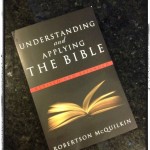
Bible Study Tip #9 — If the literal sense makes sense, seek no other sense, lest it become nonsense! Don’t twist the Bible into nonsense!
Literal Sense or Nonsense?
The Bible is filled with beautiful imagery designed by God to create stunning word pictures.
However, if we take it too far and assume that everything is merely symbolic imagery, and nothing is literal, we’ll end up twisting the Bible into nonsense.
Before we seek to determine what a passage in the Bible symbolizes, let’s first consider the possibility that:
It means what It says, and It says what It means.
The world was created in six literal days with God resting on the seventh. (Genesis 1 – 2)
Adam and Eve were tempted in the Garden of Eden by a literal serpent (Satan) that literally spoke. (Genesis 3)
A flood literally covered the earth (Genesis 6-9), the walls of Jericho literally fell (Joshua 6), and most importantly, Jesus Christ literally rose from the grave and ascended into heaven, literally defeating sin and death. (Matthew, Mark, Luke & John, Acts 1)
We will never fully understand God, His ways or His power, so don’t get hung up on things that seem impossible, just because man can’t.
As I’ve heard it said before: If God were small enough to be understood, He wouldn’t be big enough to be God.
Then are these statements also literal?
“I am the door.” (John 10:9)
Is Jesus saying He’s an actual door?
“Whoever eats My flesh and drinks My blood has eternal life, and I will raise them up at the last day. For my flesh is real food and my blood is real drink.” (John 6:54-55)
Was Jesus promoting cannabalism?
No and no. These are just figures of speech.
How can we know when a passage is literal or when it’s figurative?
Biblical scholar and pastor J. I. Packer states, “Scripture is to be interpreted in its natural, intended sense, and theological predilections must not be allowed to divert us from loyalty to what the text actually asserts.”
In other words, first and foremost, we must look at the author’s intended meaning of the passage.
In most cases it’s really not that hard to discern. We do it every day.
We understand the “intended meaning” with Figures of Speech:
If I say something “scared me to death,” no one assumes I thought I died and came back to life.
When we talk about something abstract like love, we have to use figurative language to make our meaning clear. The context of our conversation makes it clear.
Thus, clearly context is important in Bible study, as I discussed in Bible Study Tip #8 — Look for the Ripple Effect When Studying the Bible.
We understand the “intended meaning” within our current culture:
If I tell my kids to “unplug,” they know I mean to put down their cell phones, iPads, computers, TV’s, etc. In our current culture, that phrase has a clear intended meaning that it didn’t carry even twenty years ago.
When we interpret scripture, we need to consider the culture and language of the author. God inspired the authors, but He didn’t bypass their personalities or their current culture and language.
Salt is common to both Biblical culture and modern culture, but how salt was viewed is quite different. We need to understand how salt was viewed in the author’s culture to understand the intended meaning of a verse in which salt is mentioned.
We understand the “intended meaning” within our own language, including slang:
When I was in high school in Georgia, friends from Austria visited us. A group of my friends and I were sitting around just talking when one of our Austrian friends walked into the room. He asked, “What are you doing?” to which one of my friends responded, “Just jawin‘.”
My Austrian friend responded with a look of confusion.
Another friend sought to clarify. “We’re just chewing the fat.”
This didn’t help. I had to intervene. “They meant we’re just talking.”
He smiled. That phrase, he could understand.
Everyone who grew up in Georgia at that time knew that jawin’ meant moving your jaws around, but not saying anything important, which is the exact same thing as chewing the fat. My Illinois cousins might have been just as confused.
Current trends in language and culture make a difference. We can’t impose our current language trends and culture into Biblical interpretation.
We have to look at the author’s language and culture, even if that means the interpretation reveals a literal sense that seems like nonsense — like a worldwide flood.
Turning the literal sense into symbolic sense will result in nonsense.
If we try to view the world-wide flood as symbolic instead of literal, what are we to do with Noah and his family being the only people on earth after the “symbolic” waters receded?
I understand that many of the things God has done are beyond our comprehension, but this isn’t a true stumbling block. He’s God. It’s what He does.
What if it’s not clear if a passage is literal or figurative?
Some passages in the Bible will remain difficult for us to interpret. Is it literal or figurative? What does the author really mean? Is there one meaning, or two or three?
I love Robertson McQuilkin’s[*] answer to this dilemma: humility.
When the meaning is not clear, it’s better for us to admit we’re not certain than assert a meaning that could be wrong.
However, let’s also not ignore a literal interpretation just because it makes us uncomfortable to believe in a supernatural occurrence, like the parting of the Red Sea (Exodus 14:21-31), or three men being thrown into a fire and walking out without even the smell of smoke on them (Daniel 3).
When studying the Bible,
if the literal sense makes sense,
seek no other sense,
lest it become nonsense.
__________________________________
[*] For more information concerning Biblical interpretation, I recommend Understanding and Applying the Bible by Robertson McQuilkin, president emeritus of Columbia International University.






